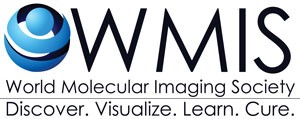WMIS Proudly Recognizes Dr. Patrick McCormick, University College London, for his work in tumor redox imaging using PET.
CULVER CITY, Calif., October 2, 2017 – The World Molecular Imaging Society (WMIS) held its 10th annual meeting of the World Molecular Imaging Congress (WMIC) September 13 – 16, 2017 in Philadelphia, PA where there were 247 oral presentations and 551 poster presentations, with awards given in each category of science. One of the most prestigious awards at the WMIC, the Young Investigator of the Year Award, recognizes a young, next-generation scientist making giant breakthroughs in the field of molecular imaging.
The 2017 WMIS Young Investigator of the Year Award was presented to Dr. Patrick McCormick at the University College London for his work titled, “Evaluation of (4S)-4-(3-[18F]fluoropropyl)-L-glutamate ([18F]FSPG) for Measurement of Intracellular Redox Status using Positron Emission Tomography.”
“The findings from this study suggest that our method will be able to detect subtle biochemical changes that precede the desired clinical outcome, namely tumor shrinkage, offering the potential of our technique in both clinical chemotherapy treatment decisions, as well as in the screening of new, more effective chemotherapeutics,” said Dr. Patrick McCormick, University College London.
McCormick plans to further validate the method and extend the study to facilitate interpretation of human imaging data. UCL just recently received funding to take this radiotracer into patient studies at the University College Hospital in London.
“Our group is interested in developing the next generation of molecular imaging agents to image cancer response and resistance to therapy,” said Tim Witney, PhD, University College London, McCormick’s PI. “Drug resistance is currently the biggest hurdle to long-term curative treatments for patients with cancer. We desperately need to understand why some patients become drug-resistant. If we can find these patients, this opens up the possibility of selecting better drugs that may prolong the life of that person. I really hope we can help with this effort. This work is just the start of a large program we are developing to try and answer this previously unanswerable problem.”
Second runners-up for the award are Dr. Suchismita Mohanty, Stanford School of Medicine, for her work titled “A novel theranostic strategy for MMP-14 expressing glioblastomas impacts survival” and Dr. Zhi Wei Tay, University of California, Berkeley, for his work titled, “Eight-fold Improvement in Magnetic Particle Imaging Resolution with Pulsed Drive Waveforms.”
ABOUT WORLD MOLECULAR IMAGING SOCIETY
The WMIS is dedicated to developing and promoting translational research through multimodality molecular imaging. The education and abstract-driven WMIC is the annual meeting of the WMIS and is held in conjunction with partner societies including the European Society for Molecular Imaging (ESMI) and the Federation of Asian Societies for Molecular Imaging (FASMI). WMIC provides a unique setting for scientists and clinicians with very diverse backgrounds to interact, present, and follow cutting-edge advances in the rapidly expanding field of molecular imaging that impacts nearly every biomedical discipline. Industry exhibits at the congress included corporations who have created the latest advances in preclinical and clinical imaging approaches and equipment, providing a complete molecular imaging educational technology showcase. For more information: www.wmis.org.
###
